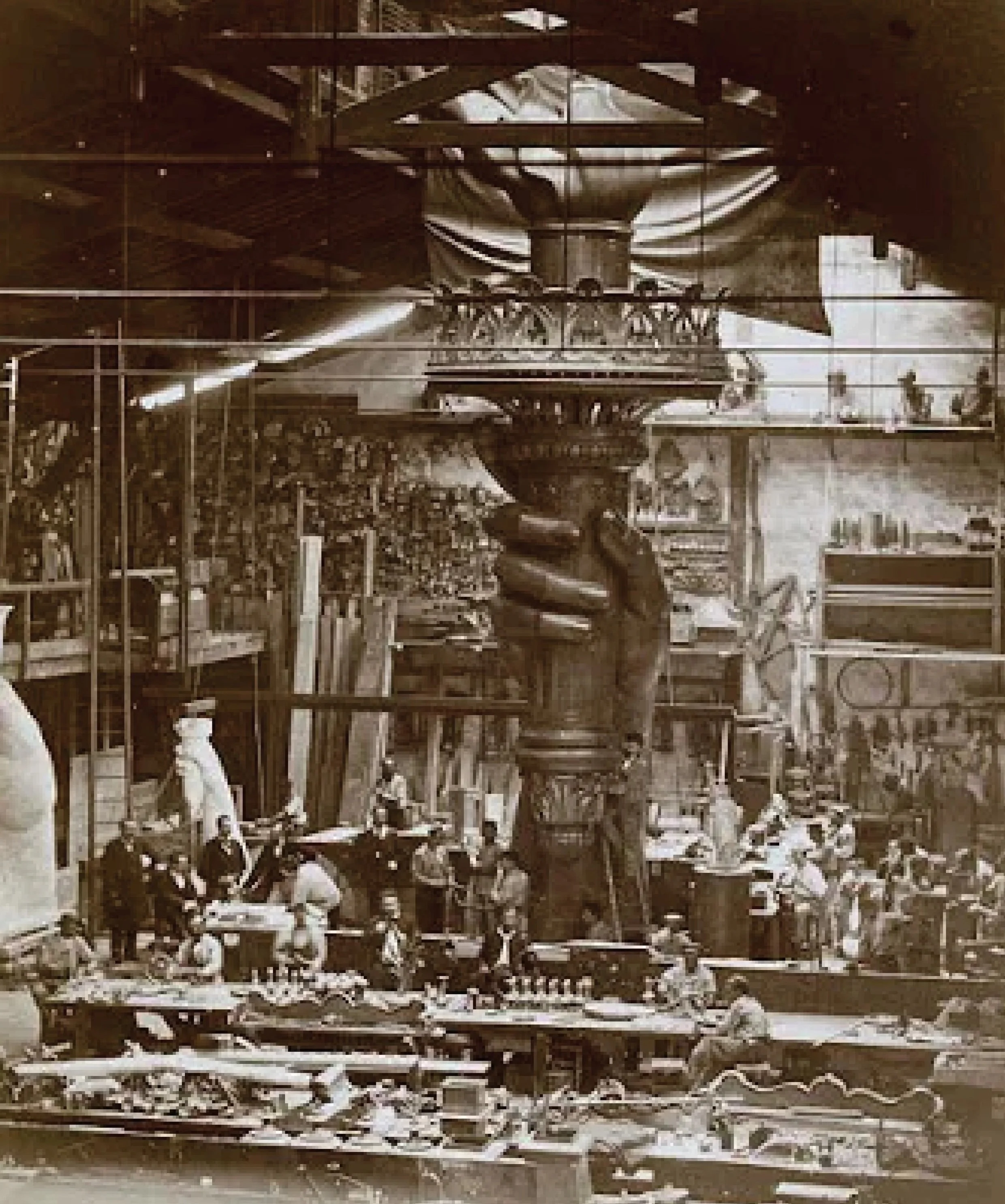From Port Said, to Say what?
CDG
48˚ 51’ 32” N | 2˚ 17’ 40” E
CDGE13332*
Gustave Eiffel was a leading innovator in iron, but one of his highest-profile projects is visible only from the inside—his studio created the armature for the Statue of Liberty rising over New York City Harbor. © Vast Compass, 2025.
Read A second iron age
Bringing Lady Liberty to life
For 2 years and 8 months metalworkers at the Gaget, Gauthier et Compagnie workshop toiled to cover Gustave Eiffel’s metal framework and bring the Statue of Liberty to life. Using a process created by Viollet-le-Duc they heated, then hammered 300 sheets of copper from the back, shaping them onto textured forms. Just 2.5mm thick (about the same as two stacked U.S. pennies), the panels were then riveted together and assembled using a system of concealed bolts and fasteners.
The statue in Gaget et Gauthier’s workshop around 1878 with artisans working their magic with repoussé in which copper is hammered from the back onto textured wooden forms. The tabula ansata (tablet invoking the law) in Libertas’ left arm reads JULY IV MDCCLXXVI, the date of the United States of America’s Declaration of Independence. Photo: Des usines a Paris
Gage and Gauthier’s workshop with the statue’s right arm and iconic torch. Public access to the torch was closed in 1916, and the original torch is now an artefact in an adjacent museum. A new torch with 24K gold gilt flame was installed in 1984. Photo credit: Des usines a Paris.
Gustave Eiffel’s signature latticework so prevalent in his namesake Tower is evident in earlier projects, from the Maria Pia Bridge in Oporto, Portugal to the Viaduc de Garabit, shown above under construction in 1883. Photo credit: Public Domain, Wikipedia Commons.
Engineering plans for Liberty Enlightening the World published in the Scientific American, June 13, 1885.
Assemblage of the Statue of Liberty in Paris, showing the bottom half of the statue erected behind scaffolding, the head and torch at its feet. The Lady’s shoe size is 879. Photo credit: Albert Fernique. Published 1883. U.S. Library of Congress.
Section by section the statue’s iron framework and copper cladding steadily rose on rue de Chazelles in Plaine-Monceau, like an alien visitor dropped into the Belle Epoque on Paris’ Right Bank.
About 4 million people visit the Statue of Liberty every year. Only a small subset brave the 377 steps to her crown. Public access to the torch has been closed since 1916. Image credit: amelier.blog4ever.com, Creative Commons.
A view looking up from inside the Statue of Liberty. Truss framing and rivets familiar from the Eiffel Tower’s design reflect structural practices coming from Gustave Eiffel’s workshop. Photo credit: debstheleo, iStock.
From Egypt to Paris to Philadelphia to Paris to New York
As fascinating as the story of the Statue of Liberty’s design and manufacture is, even more interesting is her remarkable evolution from an Egyptian woman to a Roman goddess.
Say, what?
Few people today know that Lady Liberty holding a torch to light the way for, “huddled masses yearning to breathe free”, was initially conceived as an Arab woman symbolizing Egypt Carrying the Light to Asia. That is, a massive monument echoing one of the famed Seven Wonders of the Ancient World, the Colossus of Rhodes.
To sculptor Frédéric Auguste Bartholdi it seemed an appropriate monument to raise in commemoration of a project as audacious as the newly-constructed Suez Canal in 1869, celebrating the human engineering and 1.5 million laborers who in just ten years massively re-shaped geography to link the Mediterranean and Red Seas. Intended to be raised on the banks of Port Said at the northern entrance of the canal, the project ultimately was declined by Egyptian leaders who questioned the value of funding it.
One of these is not like the others…
CAIE19031*—The Pyramid of Pharaoh Djoser near Memphis, Egypt. Dating to 2900 BCE the monument at Saqqara is recorded as the first stepped pyramid, and names Imhotep as its architect. A polymath and innovator, Imhotep is also largely credited with the world's first use of pillars in raising a building. Hollywood’s ‘The Mummy’ franchise owes Imhotep an apology.
CAIE19041*—The Great Pyramid at Giza (also, Pyramid of Khufu [Egyptian], or Cheops [Greek]). Egyptologists report that it took about 20 years to place the structure's 2.3 million stones into place. That’s about 12 blocks an hour, day and night, for the full duration. At 481 feet high it was the world’s tallest structure for over 3,800 years.
CAIE19051*—Buried by sands for millennia, the Sphinx's enigmatic presence in the Giza burial complex has transfixed scholars and visitors for more than 200 years. Napoleon’s army’s geographic surveys brought the in situ sculpture world fame, though it isn’t true that the despot's soldiers shot off the statue's nose in vandalistic target practice.
NYCE18001*—It’s a brain-bender to consider that the iconic statue of Liberty Enlightening the World at the entrance to New York Harbor welcoming immigrants was originally designed to be a Muslim woman in a kalasiris, shawl, and headscarf representing Egypt Carrying the Light to Asia from atop a pedestal at the northern end of the Suez Canal. It’s equally jarring to consider her as an Egyptian monument, her verdigris patina in stark contrast to the desert’s Pharaonic sandstone ruins.
Port Said, Egypt
An aquarelle by Frédéric Auguste Bartholdi of his project initially known as Egypt Carrying the Light to Asia, designed to celebrate completion of the Suez Canal in 1869. With a few design tweaks stylizing her as a Roman goddess, the colossus ultimately was re-purposed as Liberty Enlightening the World from a pedestal erected at the entrance to New York Harbor. Image credit: Public Domain, Wikipedia Commons.
Head of the Statue of Liberty on display on the Champ-de-Mars, Exposition Universelle, Paris, 1878. Seven rays create a diadem representing the world’s seven continents and seven oceans, symbolizing freedom as a universal right. Photograph published in 1883. Photo credit: U.S. Library of Congress.
“The Statue of Liberty arrives in New York Harbor June 17, 1885, onboard the French frigate Isère. More than 200,000 New Yorkers came out to meet her. Photograph take from on top of the awaiting unfinished pedestal of the statue. The Isère is recognizable (sic) from its white hull.” Photo credit and text: Public Domain, Wikipedia Commons.
Rejected, re-conceived
In 1865 French historian and abolitionist Édouard de Laboulaye suggested a monument commemorating the United States’ centennial in 1876. The gift from France was to symbolize the alliance between the two nations. In 1870 Bartholdi provided Laboulaye with sketches of a woman in robes as the proposed monument. It’s difficult not to assume that his rejected Egyptian project from just a year earlier wasn’t re-conceived in the process. That is, his statue of a Muslim woman looking east becoming Libertas, a Roman-era goddess representing the western ideal of freedom. The model for the Egyptian colossus was a female fellah (peasant), while Lady Liberty’s face is modeled on Bartholdi’s mother.
Shipping and handling included (but not the pedestal)
In today’s currency Liberty Enlightening the World was a $5.5 million investment by France for the statue alone. They also covered shipping the 450,000-pound sculpture aboard the French Navy steamer Isère. The U.S. would need to fund the sculptural masonry base on which it rests.
Ironically, a New York...woman...would help raise the funds to build the pedestal for a statue of...a woman...giving hope to the world’s downtrodden and disenfranchised. A child of immigrants, she lent her talents to a cause that symbolically celebrated her adopted nation’s values, even as that nation simultaneously denied her equal rights because she was...a woman.
By 1920 Emma Lazarus would be dead for 33 years when the United States of America finally enshrined in its Constitution the right of suffrage to white women.
That is, the right to vote.
Recommendation
Who doesn’t love the amazing work that the creatives and makers at LEGO get up to for the kid in all of us? The Great Pyramid of Giza restores the Ahramat Branch of the Nile, a canal more than a half mile wide and 80 feet deep. Flowing near the Giza plateau during the Old Kingdom, the waterway was used to transport massive quantities of stone and buildling materials for constructing the Giza pyramid complex.
LEGO Architecture Great Pyramid of Giza Set 21058
LEGO’s Great Pyramid of Giza set is comprised of 1,476 pieces, a far smaller number than the 2.3 million stones in the actual pyramid. The good news is it won’t take 20 years, 24 hours a day to complete!



















